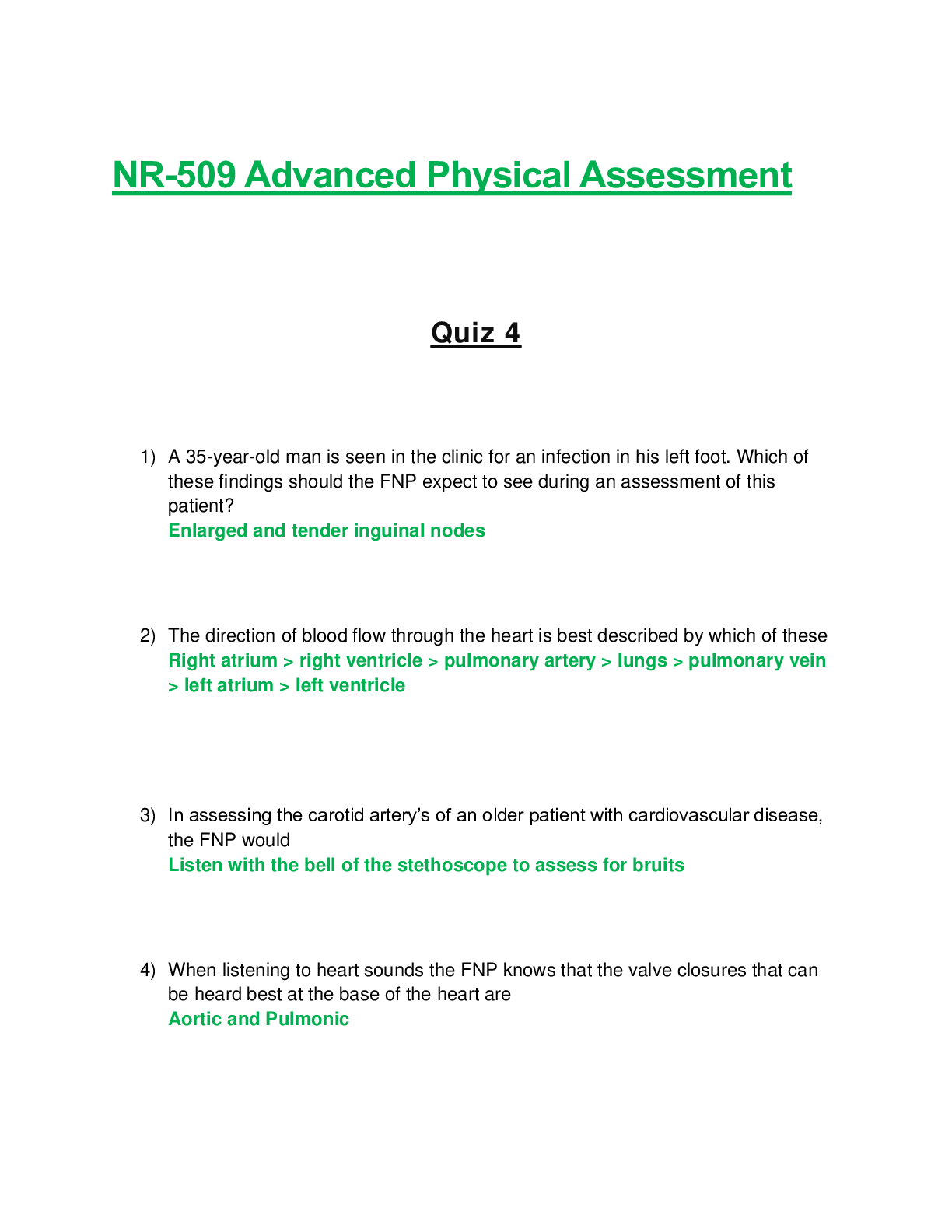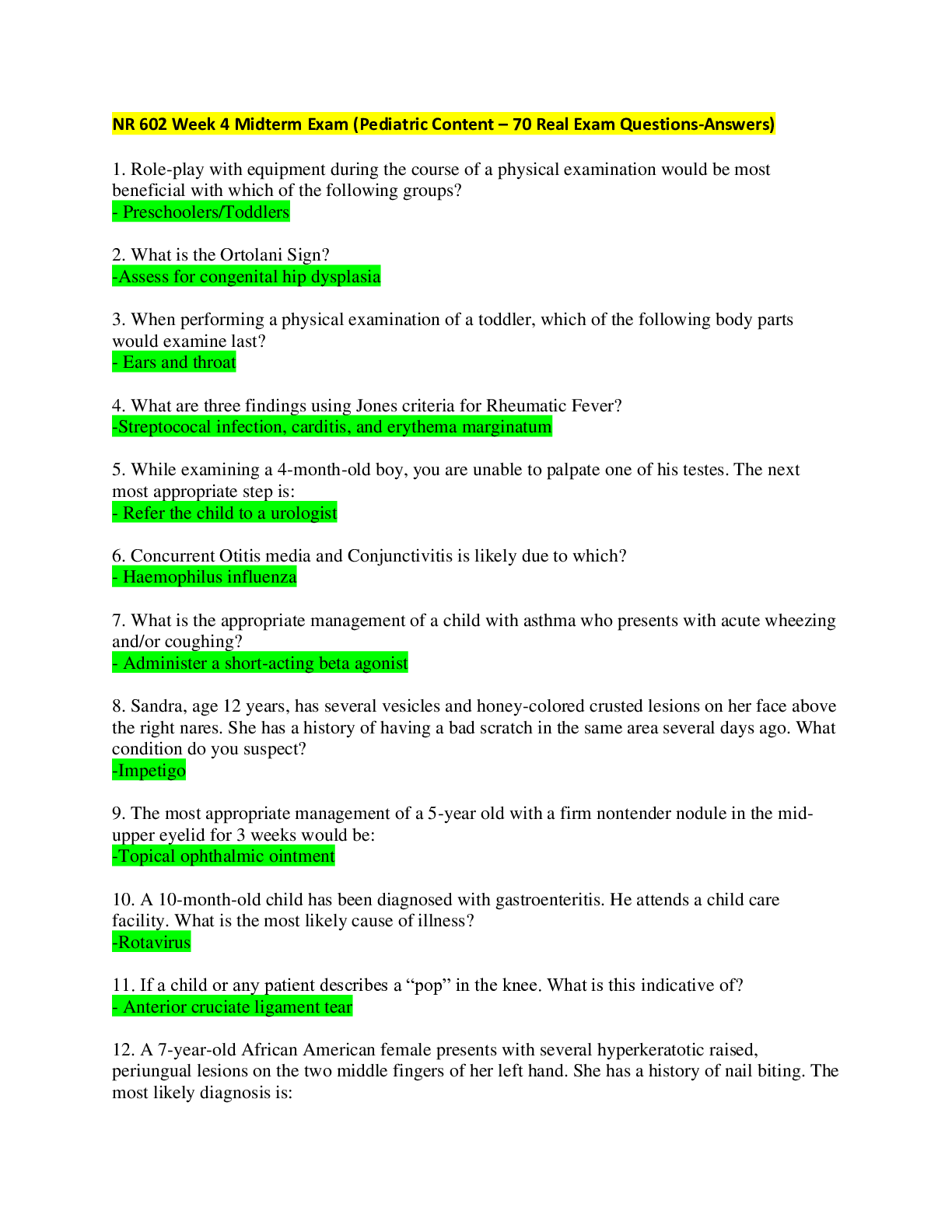NR 507 / NR507 Week 4 Midterm Exam Answers, Attempt Score;58 Out of 60.
Document Content and Description Below
NR 507 Week 4 Midterm Exam Answers The coronary ostia are located in the: (Points : 2) Left ventricle Aortic valve Coronary sinus Aorta Where in the respiratory tract do the majority of foreign object... s aspirated by children finally lodge? (Points : 2) Trachea Left lung Bronchus Bronchioles Which type of antibody is involved in type I hypersensitivity reaction? (Points : 2) IgA IgE IgG IgM Hypersensitivity is best defined as a(an): (Points : 2) Disturbance in the immunologic tolerance of self-antigens Immunologic reaction of one person to the tissue of another person Altered immunologic response to an antigen that results in disease Undetectable immune response in the presence of antigens What is the final stage of the infectious process? (Points : 2) Colonization Invasion Multiplication Spread 1. Colonization 2. Invasion 3. Multiply 4. spread The function of the foramen ovale in a fetus allows what to occur? (Points : 2) Right-to-left blood shunting Left-to-right blood shunting Blood flow from the umbilical cord Blood flow to the lungs It has been determined that a tumor is in stage 2. What is the meaning of this finding? (Points : 2) Cancer is confined to the organ of origin. Cancer has spread to regional structures. Cancer is locally invasive. Cancer has spread to distant sites What is the primary problem resulting from respiratory distress syndrome (RDS) of the newborn? (Points : 2) Consolidation Pulmonary edema Atelectasis Bronchiolar plugging Which statement is true concerning the IgM? (Points : 2) IgM is the first antibody produced during the initial response to an antigen. IgM mediates many common allergic responses. IgM is the most abundant class of immunoglobulins. IgM is capable of crossing the human placenta. Apoptosis is a(an): (Points : 2) Normal mechanism for cells to self-destruct when growth is excessive Antigrowth signal activated by the tumor-suppressor gene Rb Mutation of cell growth stimulated by the TP53 gene Transformation of cells from dysplasia to anaplasia Which statement concerning benign tumors is true? (Points : 2) The resulting pain is severe. Benign tumors are not encapsulated. Benign tumors are fast growing. The cells are well-differentiated. Which complex (wave) represents the sum of all ventricular muscle cell depolarizations? (Points : 2) PRS QRS QT interval P Which organism is a common sexually transmitted bacterial infection? (Points : 2) Staphylococcus aureus Clostridium perfringens Helicobacter pylori Treponema pallidum Which organ is stimulated during the alarm phase of the general adaptation syndrome (GAS)? (Points : 2) Adrenal cortex Hypothalamus Anterior pituitary Limbic system What is the role of caretaker genes? (Points : 2) Maintenance of genomic integrity Proliferation of cancer cells Secretion of growth factors Restoration of normal tissue structure Where are antibodies produced? (Points : 2) Helper T lymphocytes Thymus gland Plasma cells Bone marrow The lung is innervated by the parasympathetic nervous system via which nerve? (Points : 2) Vagus Phrenic Brachial Pectoral What physical sign is the result of turbulent blood flow through a vessel? (Points : 2) Increased blood pressure during periods of stress Bounding pulse felt on palpation Cyanosis observed on excretion Murmur heard on auscultation What is the primary cause of respiratory distress syndrome (RDS) of the newborn? (Points : 2) Immature immune system Small alveoli Surfactant deficiency Anemia What is the fundamental physiologic manifestation of anemia? (Points : 2) Hypotension Hyperesthesia Hypoxia Ischemia Which term is used to describe a muscle cell showing a reduced ability to form new muscle while appearing highly disorganized? (Points : 2) Dysplasia Hyperplasia Myoplasia Anaplasia Which of the following is classified as a megaloblastic anemia? (Points : 2) Iron deficiency Pernicious Sideroblastic Hemolytic How is most carbon dioxide (CO2) in the blood transported? (Points : 2) Attached to oxygen In the form of bicarbonate Combined with albumin Dissolved in the plasma Question 24.24. Which immunoglobulin (Ig) is present in childhood asthma? (Points : 2) IgM IgG IgE IgA Question 25.25. An individual is more susceptible to infections of mucous membranes when he or she has a seriously low level of which immunoglobulin antibody? (Points : 2) IgG IgM IgA IgE Question 26.26. Examination of the throat in a child demonstrating signs and symptoms of acute epiglottitis may contribute to which life-threatening complication? (Points : 2) Retropharyngeal abscess Laryngospasms Rupturing of the tonsils Gagging induced aspiration Question 27.27. Which laboratory test is considered adequate for an accurate and reliable diagnosis of gonococcal urethritis in a symptomatic man? (Points : 2) Ligase chain reaction (LCR) Gram-stain technique Polymerase chain reaction (PCR) DNA testing Question 28.28. Which primary characteristic is unique for the immune response? (Points : 2) The immune response is similar each time it is activated. The immune response is specific to the antigen that initiates it. The response to a specific pathogen is short term. The response is innate, rather than acquired. Question 29.29. When an individual aspirates food particles, where would the nurse expect to hear decreased or absent breath sounds? (Points : 2) Left lung Right lung Trachea Carina Question 30.30. What is the primary site for uncomplicated local gonococci infections in men? (Points : 2) Epididymis Lymph nodes Urethra Prostate Question 31.31. Deficiencies in which element can produce depression of both B- and T-cell function? (Points : 2) Iron Zinc Iodine Magnesium Question 32.32. An infant has a loud, harsh, holosystolic murmur and systolic thrill that can be detected at the left lower sternal border that radiates to the neck. These clinical findings are consistent with which congenital heart defect? (Points : 2) Atrial septal defect (ASD) Ventricular septal defect (VSD) Patent ductus arteriosus (PDA) Atrioventricular canal (AVC) defect Question 33.33. Which compensatory mechanism is spontaneously used by children diagnosed with tetralogy of Fallot to relieve hypoxic spells? (Points : 2) Lying on their left side Performing the Valsalva maneuver Squatting Hyperventilating Question 34.34. In a normal, nonmutant state, an oncogene is referred to as a: (Points : 2) Basal cell Target cell Caretaker gene Proto-oncogene Question 35.35. Infants are most susceptible to significant losses in total body water because of an infant’s: (Points : 2) High body surface–to–body size ratio Slow metabolic rate Kidneys are not mature enough to counter fluid losses Inability to communicate adequately when he or she is thirsty Question 36.36. A person with type O blood is considered to be the universal blood donor because type O blood contains which of the following? (Points : 2) No antigens No antibodies Both A and B antigens Both A and B antibodies Question 37.37. Which type of immunity is produced by an individual after either natural exposure to the antigen or after immunization against the antigen? (Points : 2) Passive-acquired immunity Active-acquired immunity Passive-innate immunity Active-innate immunity Question 38.38. Erythrocyte life span of less than 120 days, ineffective bone marrow response to erythropoietin, and altered iron metabolism describe the pathophysiologic characteristics of which type of anemia? (Points : 2) Aplastic Sideroblastic Anemia of chronic disease Iron deficiency Question 39.39. How is most of the oxygen in the blood transported? (Points : 2) Dissolved in plasma Bound to hemoglobin In the form of carbon dioxide (CO2) Bound to protein Question 40.40. What is the action of urodilatin? (Points : 2) Urodilatin causes vasoconstriction of afferent arterioles. It causes vasodilation of the efferent arterioles. Urodilatin inhibits antidiuretic hormone secretion. It inhibits salt and water reabsorption. Question 41.41. What is the chief predisposing factor for respiratory distress syndrome (RDS) of the newborn? (Points : 2) Low birth weight Alcohol consumption during pregnancy Premature birth Smoking during pregnancy Question 42.42. What is the most common cause of insufficient erythropoiesis in children? (Points : 2) Folic acid deficiency Iron deficiency Hemoglobin abnormality Erythrocyte abnormality Question 43.43. What are the abnormalities in cytokines found in children with cystic fibrosis (CF)? (Points : 2) Deficit of interleukin (IL)–1 and an excess of IL-4, IL-12, and interferon-alpha (IFN- Deficit of IL-6 and an excess of IL-2, IL-8, and granulocyte colony-stimulating factor (G-CSF) Deficit of IL-10 and an excess of IL-1, IL-8, and TNF- Deficit of IL-3 and an excess of IL-14, IL-24, and colony-stimulating factor (CSF) Question 44.44. Which manifestations of vasoocclusive crisis are associated with sickle cell disease (SCD) in infants? (Points : 2) Atelectasis and pneumonia Edema of the hands and feet Stasis ulcers of the hands, ankles, and feet Splenomegaly and hepatomegaly Question 45.45. What process allows the kidney to respond to an increase in workload? (Points : 2) Glomerular filtration Secretion of 1,25-dihydroxyvitamin D3 Increased heart rate Compensatory hypertrophy Question 46.46. What is the direct action of atrial natriuretic hormone? (Points : 2) Sodium retention Sodium excretion Water retention Water excretion Question 47.47. Which cells have phagocytic properties similar to monocytes and contract like smooth muscles cells, thereby influencing the glomerular filtration rate? (Points : 2) Principle cells Podocin cells Mesangial cells Intercalated cells Question 48.48. Research supports the premise that exercise has a probable impact on reducing the risk of which cancer? (Points : 2) Liver Endometrial Stomach Colon Question 49.49. What effect do natriuretic peptides have during heart failure when the heart dilates? (Points : 2) Stimulates antidiuretic hormones. Inhibits antidiuretic hormones. Stimulates renin and aldosterone. Inhibits renin and aldosterone. Question 50.50. Which T-lymphocyte phenotype is the key determinant of childhood asthma? (Points : 2) Cluster of differentiation (CD) 4 T-helper Th1 lymphocytes CD4 T-helper Th2 lymphocytes CD8 cytotoxic T lymphocytes Memory T lymphocytes Question 51.51. In which primary immune deficiency is there a partial-to-complete absence of T-cell immunity? (Points : 2) Bruton disease DiGeorge syndrome Reticular dysgenesis Adenosine deaminase deficiency What is the ratio of coronary capillaries to cardiac muscle cells? (Points : 2) 1:1 (one capillary per one muscle cell) 1:2 (one capillary per two muscle cells) 1:4 (one capillary per four muscle cells) 1:10 (one capillary per ten muscle cells) Question 53.53. The most common site of metastasis for a patient diagnosed with prostate cancer is which location? (Points : 2) Bones Brain Bladder Kidney Question 54.54. Which cardiac chamber has the thinnest wall and why? (Points : 2) The right and left atria; they are low-pressure chambers that serve as storage units and conduits for blood. The right and left atria; they are not directly involved in the preload, contractility, or afterload of the heart. The left ventricle; the mean pressure of blood coming into this ventricle is from the lung, which has a low pressure. The right ventricle; it pumps blood into the pulmonary capillaries, which have a lower pressure compared with the systemic circulation. Question 55.55. The only surface inside the nephron where cells are covered with microvilli to increase the reabsorptive surface area is called the: (Points : 2) Proximal convoluted tubules Distal tubules Ascending loop of Henle Descending loop of Henle Question 56.56. How high does the plasma glucose have to be before the threshold for glucose is achieved? (Points : 2) 126 mg/dl 150 mg/dl 180 mg/dl 200 mg/dl Question 57.57. Which cytokines initiate the production of corticotropin-releasing hormone (CRH)? (Points : 2) IL–1 and IL-6 IL-2 and TNF- IFN and IL-12 TNF-ß and IL-4 Question 58.58. Which hormone is synthesized and secreted by the kidneys? (Points : 2) Antidiuretic hormone Aldosterone Erythropoietin Angiotensinogen Question 59.59. What effects do exercise and body position have on renal blood flow? (Points : 2) Exercise and body position activate renal parasympathetic neurons and cause mild vasoconstriction. They activate renal sympathetic neurons and cause mild vasoconstriction. Both activate renal parasympathetic neurons and cause mild vasodilation. They activate renal sympathetic neurons and cause mild vasodilation. Question 60.60. The glomerular filtration rate is directly related to which factor? (Points : 2) Perfusion pressure in the glomerular capillaries Diffusion rate in the renal cortex Diffusion rate in the renal medulla Glomerular active transport [Show More]
Last updated: 1 year ago
Preview 1 out of 11 pages
 (1).png)
Reviews( 0 )
Document information
Connected school, study & course
About the document
Uploaded On
Apr 19, 2021
Number of pages
11
Written in
Additional information
This document has been written for:
Uploaded
Apr 19, 2021
Downloads
0
Views
155



.png)










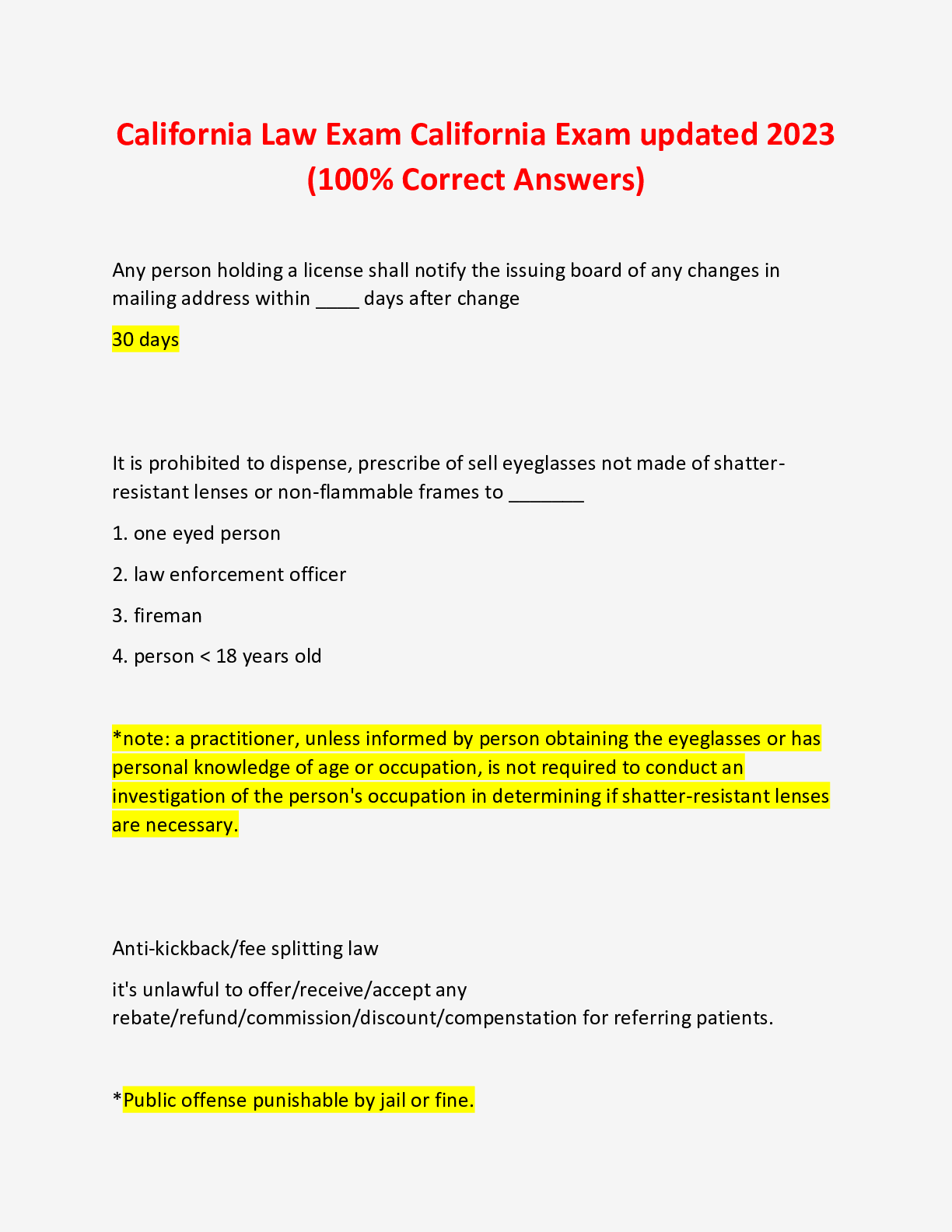


 – Chamberlain College of Nursing.png)

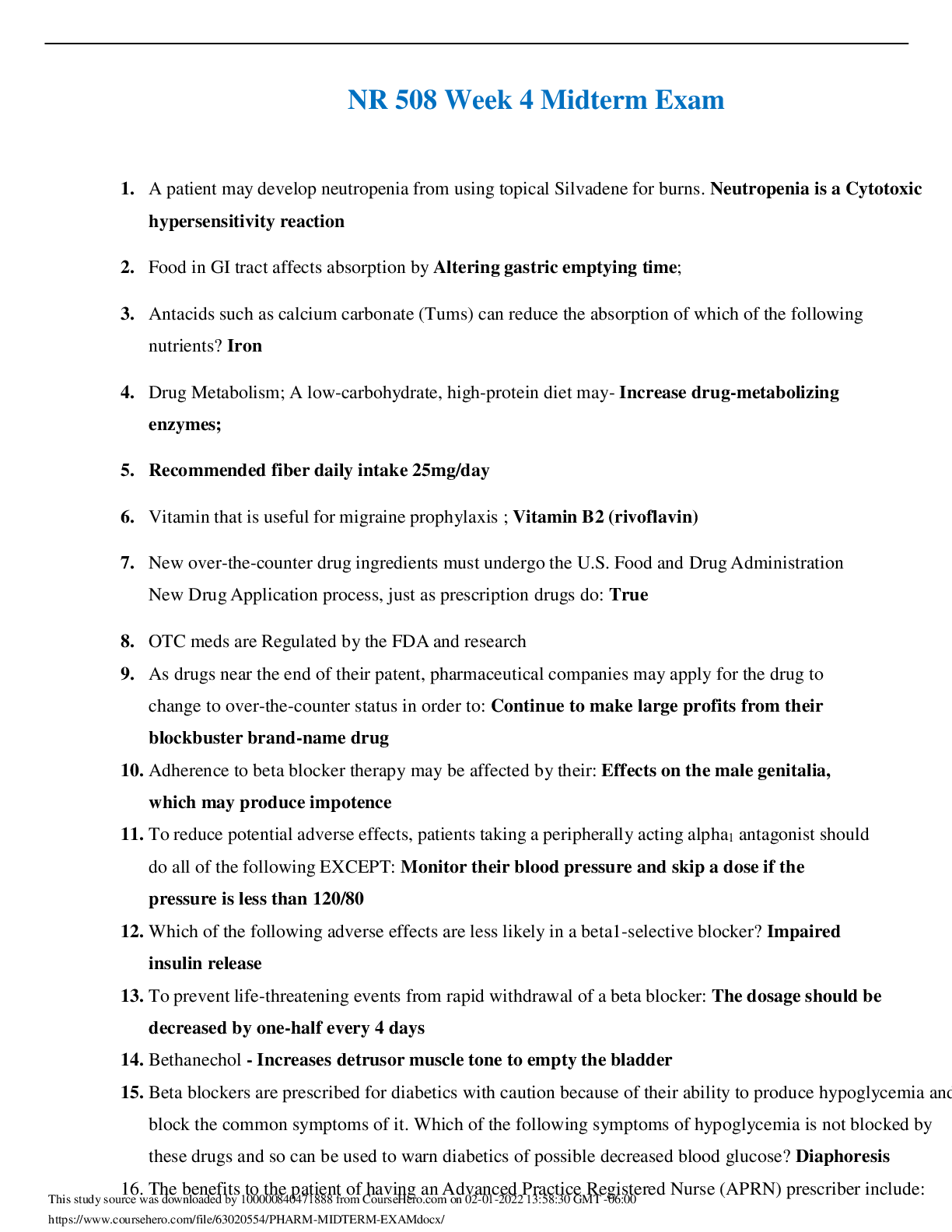
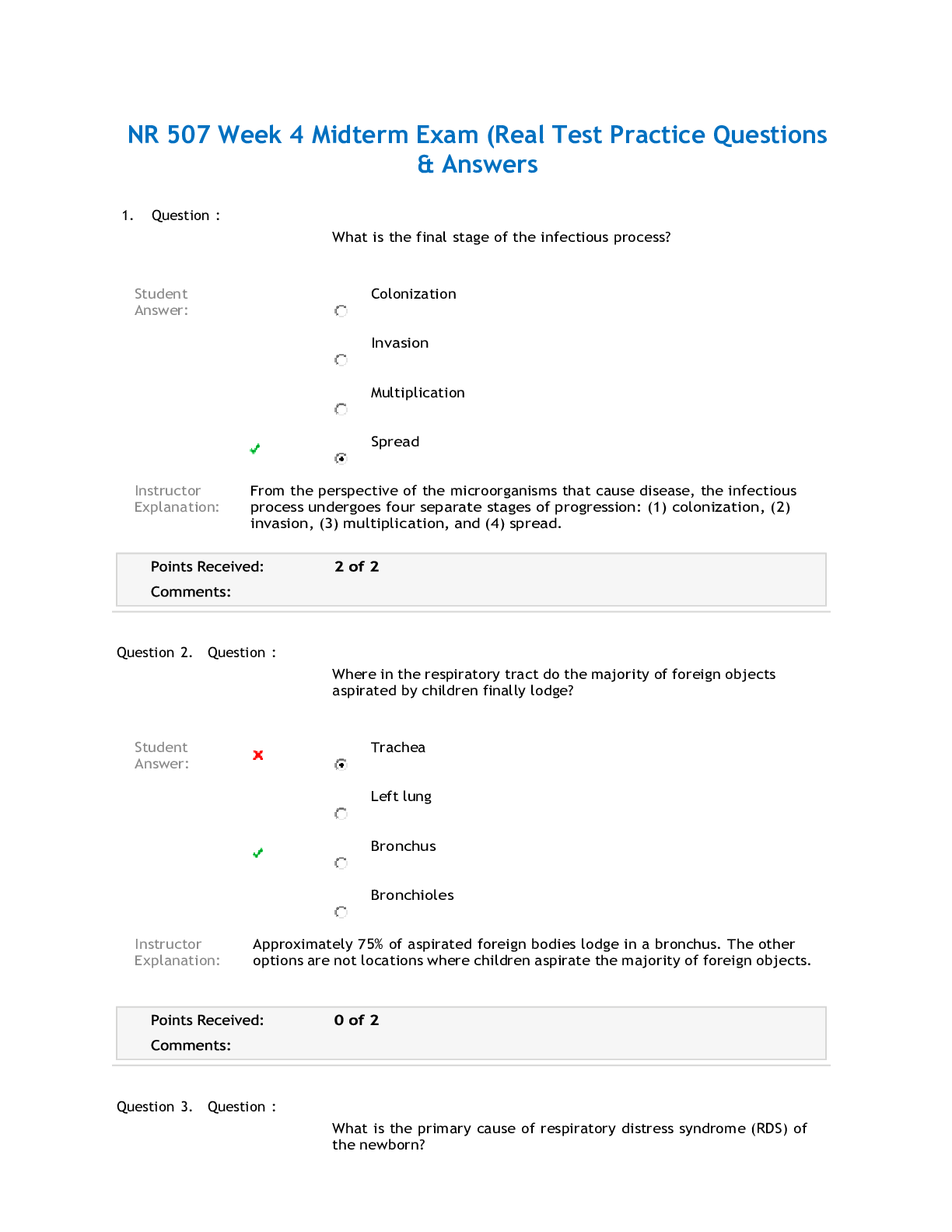

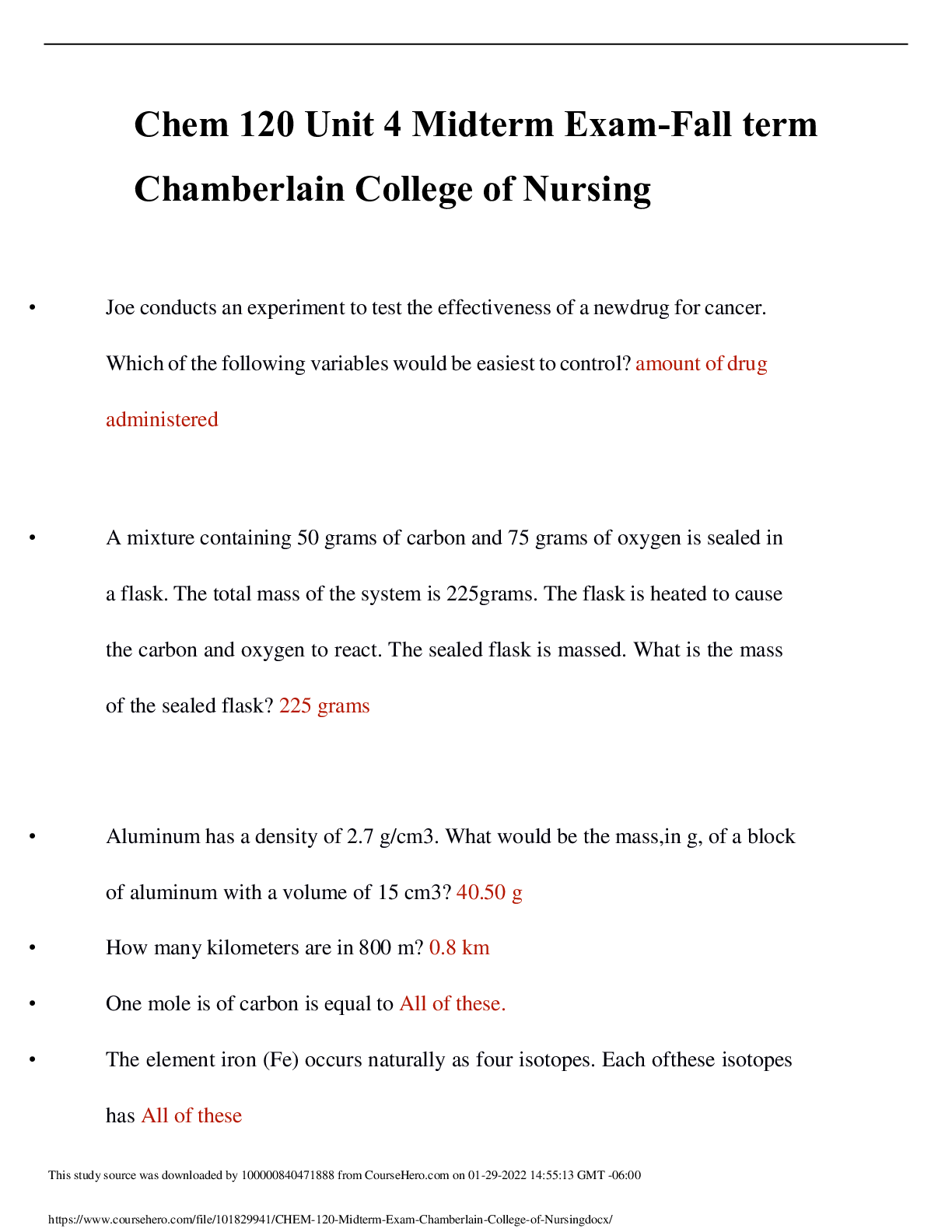

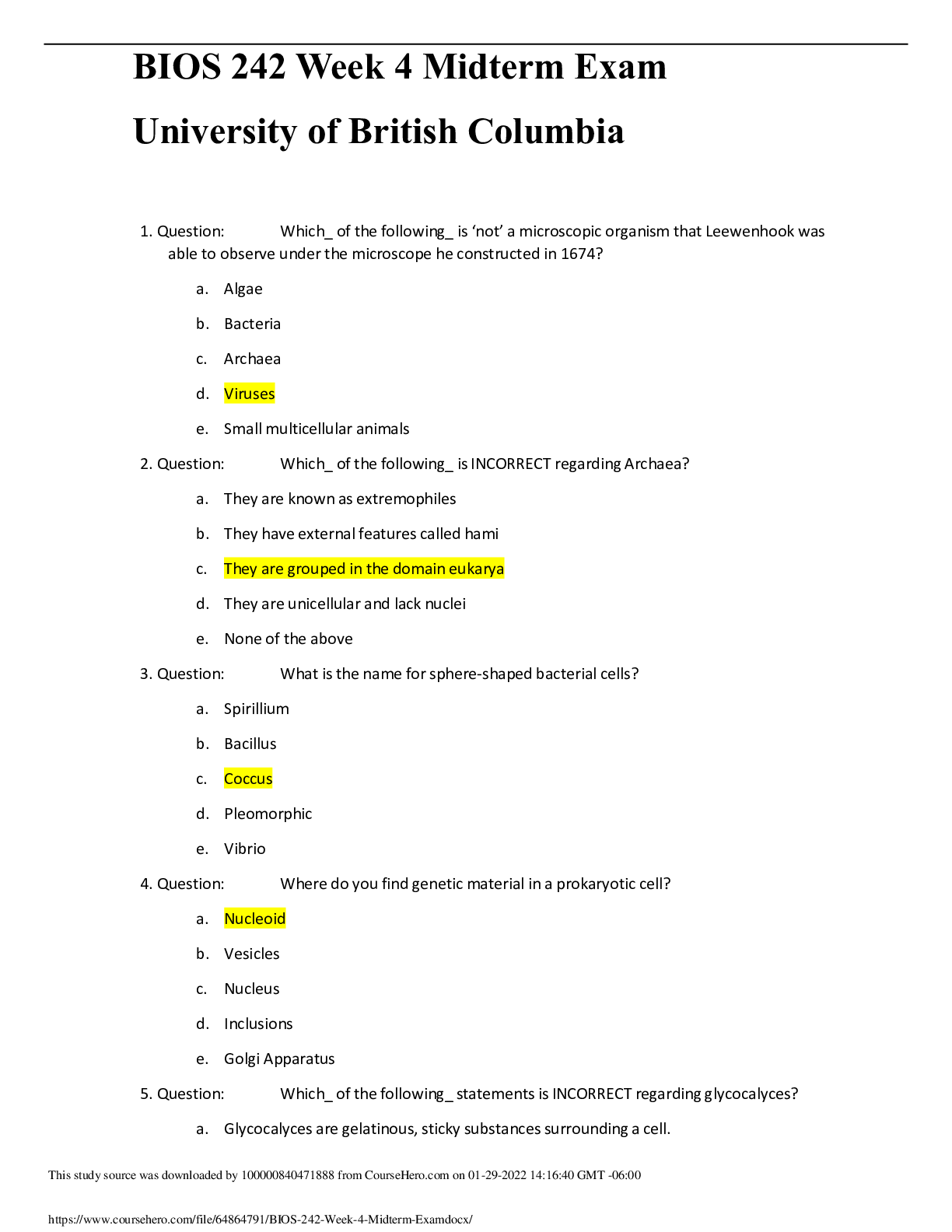
 – Chamberlain College of Nursing.png)




